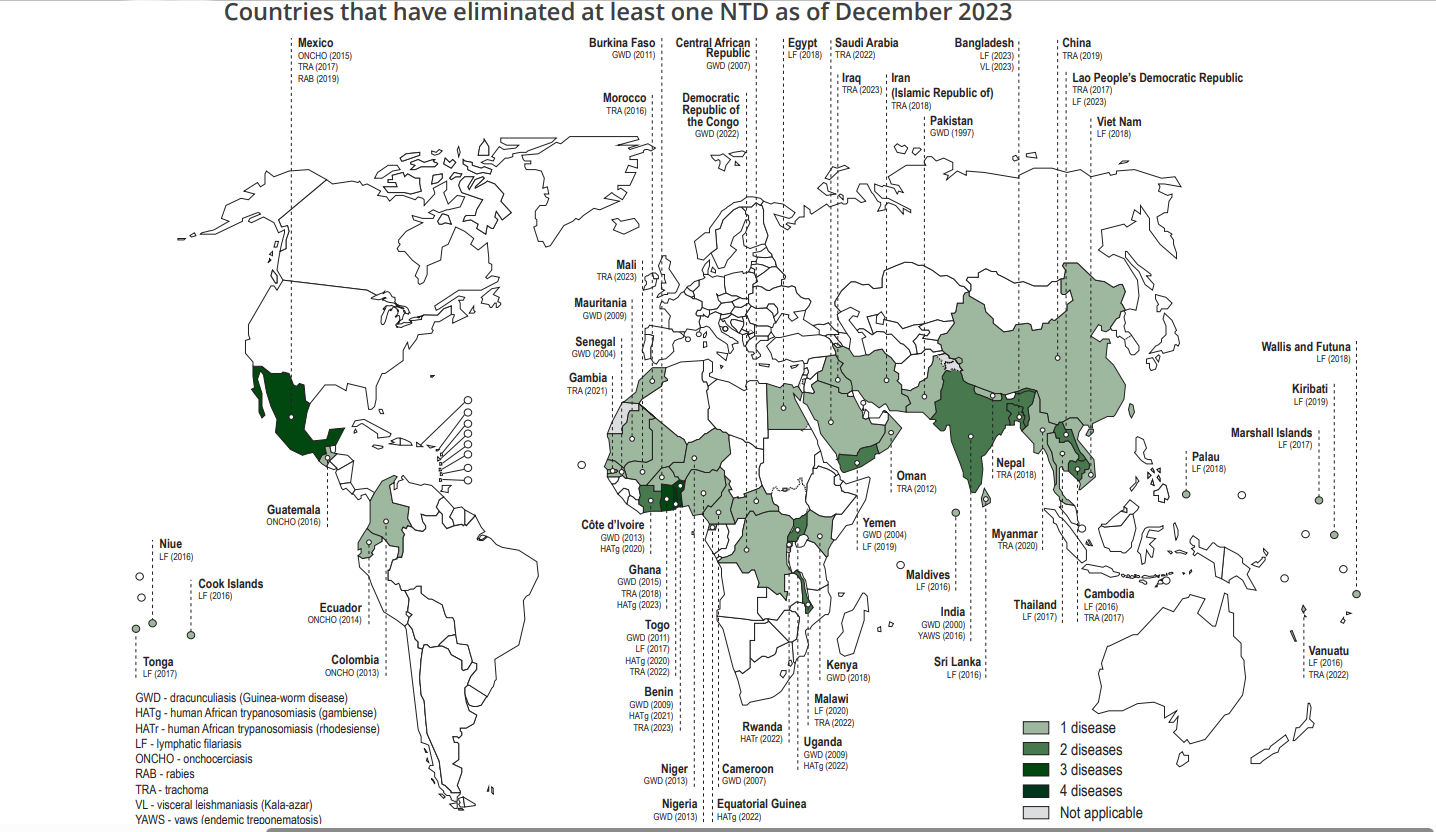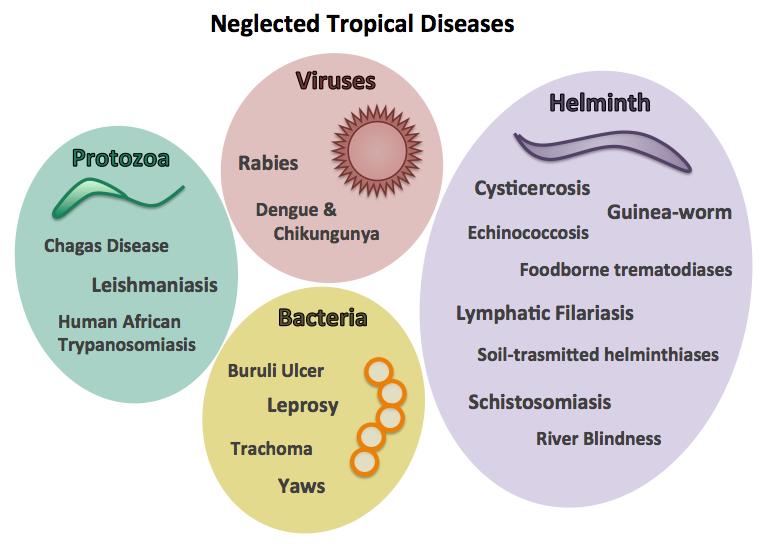Science & Technology
Global Report on Neglected Tropical Diseases 2024
- 18 May 2024
- 7 min read
For Prelims: World Health Assembly, World Health Organization (WHO), Neglected tropical diseases (NTD), HIV/AIDS, tuberculosis
For Mains: Key highlights of Global report on neglected tropical diseases (NTD) of 2024, About Neglected Tropical Diseases and related initiatives.
Why in News?
Ahead of the World Health Assembly 77th session, the World Health Organization (WHO) released its Global report on neglected tropical diseases (NTD) of 2024.
- The report provides an account of the progress made in 2023 towards the implementation of the Road map for neglected tropical diseases 2021-2030.
What are the Key highlights of the WHO Report?
- Global:
- Status for 2023:
- As of December 2023, a total of 50 countries have successfully eliminated at least one NTD, marking the halfway point towards the 2030 target of 100 countries.
- 5 countries were acknowledged by WHO for eliminating one NTD, and 1 country for eliminating two NTDs.
- In July 2023, Iraq became the 50th country to eliminate at least one NTD. This event marks the halfway point towards achieving the 100-country target set for 2030.
- Noma was added to the list of NTDs in 2023.
- In October 2023, Bangladesh became the first country to be validated by WHO for eliminating visceral leishmaniasis as a public health problem.
- Status for 2022:
- In 2022, 1.62 billion people required interventions against neglected tropical diseases (NTDs), reflecting a 26% decrease from 2010, but still dedicated efforts are needed to attain the road map’s global target of a 90% reduction by 2030.
- In 2022, approximately 848 million people received treatment for at least one NTD through preventive chemotherapy interventions, 49 million fewer than in 2021 but 50 million more than in 2020.
- As of the end of 2022, the number of reported deaths from vector-borne NTDs has increased by 22% (as compared with 2016).
- Status for 2023:
- India:
- India was certified free of NTDs like dracunculiasis and yaws.
- India, which has the highest disease burden, treated about 117 million fewer people for lymphatic filariasis and soil-transmitted helminthiasis in 2022 compared to 2021.
- 40.56% of India's population needed interventions against NTDs in 2022.
- Key challenges highlighted in the report include slow post Covid-19 recovery, funding uncertainties, geopolitical disruptions, climate change, gaps in knowledge and tools, and insufficient data in addressing NTDs.
What are the Key Facts About Neglected Tropical Diseases (NTDs)?
- About:
- According to WHO, Neglected tropical diseases (NTDs) are a diverse group of conditions caused by a variety of pathogens (including viruses, bacteria, parasites, fungi and toxins) and are associated with devastating health, social and economic consequences.
- NTDs are mainly prevalent among impoverished communities in tropical areas, although some have a much larger geographical distribution.
- Factors Contributing to these Diseases are Being "Neglected":
- The epidemiology of NTDs is complex and often related to environmental conditions.
- Epidemiology is the study of the determinants, occurrence, and distribution of health and disease in a defined population.
- Many of them are vector-borne, have animal reservoirs and are associated with complex life cycles.
- Compared to diseases like HIV/AIDS, malaria, and tuberculosis, NTDs receive significantly less funding for research and development of treatments.
- The epidemiology of NTDs is complex and often related to environmental conditions.
What are the Global and Indian Initiatives to tackle NTDs?
- Global Initiatives:
- WHO's 2021-2030 Roadmap: This ambitious plan prioritises impact over simply treating NTDs. It emphasises collaboration across healthcare, sanitation, and communities. Additionally, it encourages countries to take ownership of their NTD programs.
- 2012 London Declaration: This international agreement recognises the global burden of NTDs and promotes a unified approach to eliminate them.
- Indian Initiatives:
- Elimination Programs: India has successfully eliminated guinea worm, trachoma, and yaws. The Accelerated Plan for Elimination of Lymphatic Filariasis (APELF) aims to achieve the same for this disease by 2027.
- WHO Collaborations: India partners with WHO in regional alliances. For instance, a 2005 initiative with Bangladesh and Nepal focuses on early diagnosis and treatment of Kala-azar.
- Mass Drug Administration (MDA): This program involves regular distribution of free anti-parasitic medication in high-risk areas to prevent NTD transmission.
- Vector Control: Programs like Indoor Residual Spraying target insect breeding grounds to prevent the spread of NTDs like Kala-azar.
- Financial Assistance: Wage compensation schemes help individuals affected by NTDs, particularly those with Post-Kala Azar Dermal Leishmaniasis, manage the financial burden of their illness.
Conclusion
The 2024 WHO report shows progress in the fight against neglected tropical diseases. Several countries eliminated these diseases in 2023, but more needs to be done to reach global targets. Challenges like funding gaps and the lingering effects of COVID-19 threaten progress. Increased national and global collaboration is necessary for achieving a future free from neglected tropical diseases.
|
Drishti Mains Question: Q. Discuss key highlights of Global report on neglected tropical diseases (NTD), 2024 by WHO, Also, mention about Neglected Tropical Diseases and related initiatives. |
UPSC Civil Services Examination Previous Year Question (PYQ)
Prelims
Q. Which of the following are the objectives of ‘National Nutrition Mission’? (2017)
- To create awareness relating to malnutrition among pregnant women and lactating mothers.
- To reduce the incidence of anaemia among young children, adolescent girls and women.
- To promote the consumption of millets, coarse cereals and unpolished rice.
- To promote the consumption of poultry eggs.
Select the correct answer using the code given below:
(a) 1 and 2 only
(b) 1, 2 and 3 only
(c) 1, 2 and 4 only
(d) 3 and 4 only
Ans: (a)
Mains
Q. “Besides being a moral imperative of a Welfare State, primary health structure is a necessary precondition for sustainable development.” Analyse. (2021)
Q. Appropriate local community-level healthcare intervention is a prerequisite to achieve ‘Health for All’ in India. Explain. (2018)






